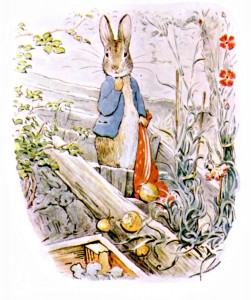Let Peter Rabbit Play in the Garden

Originally appears in the Spring 2014 issue
THE DAY I SAT DOWN in a lesson with a copy of Beatrix Potter’s The Tales of Peter Rabbit, potted herb plants, and a basket of nature journals I wasn’t sure if my elementary students were going to love the lesson or revolt. Lower elementary students can be fickle. One minute they are pretending to be rabbits hopping around the schoolyard and the next they are scientific philosophers. Regardless of behavior, they are always quick to declare they ARE NOT BABIES!
So you can understand my apprehension at presenting a lesson I knew had the potential for fantastic interdisciplinary learning experiences, but also had the potential to exasperate “big kids.” I decided to trust my instinct, the inspiration that is the life of Beatrix Potter, and the understanding that if I am excited enough about something the students will be too. The gamble paid off and a fantastic new series of lessons sprouted that incorporated literacy, observation, botany, history, place studies, writing, and art, with a long term eco-literacy promise.
I loved Beatrix Potter’s Tales when I was young but besides that, I knew nothing about her life and work. Through her child-friendly creative writing and art I discovered a complex woman who was an exemplary observer of the natural world and a groundbreaking conservationist whose work has set historic precedents in land conservation, mycology and, of course, children’s literature. It is impossible to separate Potter’s personal relationship with nature and her conservation efforts from her storytelling–but that is a perfect starting point for Beatrix Potter as a model for integrating writing and nature experience. She had personal relationships with most of her animal characters, the stories are grounded in authentic events, and the gardens and flora are always botanically accurate from existing locations around her home Hill Top Farm. This is where I begin with the students.
I present the Tale of Peter Rabbit and ask the students if they remember this story. Avoiding the actual storyline at this point, I move directly into an exploration of the illustrations as scientific documentation. We examine their precision, discuss how many of these animals were her pets, and how the anatomical accuracy came from many hours of close observation.
To view the photo-rich magazine version, click here.
If you are not already a subscriber, please subscribe to read the full article
Kelly Johnson is an author, artist, and the creator of a world of nature and arts-based educational resources, consulting, and workshops. Discover how to creatively integrate nature into your educational environment by joining in the fun at www.wingswormsandwonder.com. She lives in Neptune Beach, Florida.
Leave a Reply Cancel reply
You must be logged in to post a comment.





